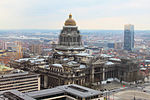Poelaert Elevators
Buildings and structures in BrusselsElevatorsTransport in BrusselsTransport infrastructure completed in 2002

The Poelaert Elevators (French: Ascenseurs Poelaert; Dutch: Poelaertliften), in popular language Elevators of the Marolles (French: Ascenseurs des Marolles; Dutch: Liften van de Marollen) is a public elevator in the Marollen quarter of Brussels. They connect the lower and upper town at Brueghel the Elder Square (French: Square Breughel l'Ancien; Dutch: Breughel de Oudeplein) with Poelaert Square (French: Place Poelaert; Dutch: Poelaertplein). It is in the vicinity of the Palace of Justice. The elevator consists of two independent elevators, hence the plural sometimes used for its name, 'elevators' (French: ascenseurs; Dutch: liften).
Excerpt from the Wikipedia article Poelaert Elevators (License: CC BY-SA 3.0, Authors, Images).Poelaert Elevators
Rue de l'Épée - Zwaardstraat, City of Brussels Pentagon (Brussels)
Geographical coordinates (GPS) Address External links Nearby Places Show on map
Geographical coordinates (GPS)
| Latitude | Longitude |
|---|---|
| N 50.838027777778 ° | E 4.3511111111111 ° |
Address
Ascenseurs Poelaert - Poelaertliften (Ascenseur des Marolles - Lift van de Marollen)
Rue de l'Épée - Zwaardstraat 1
1000 City of Brussels, Pentagon (Brussels)
Belgium
Open on Google Maps










